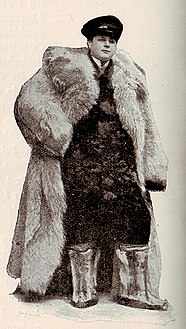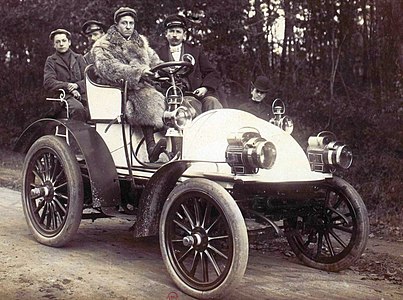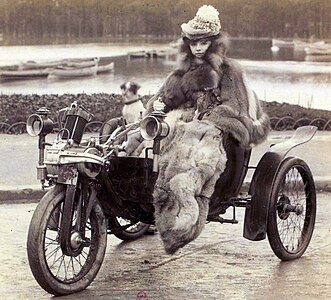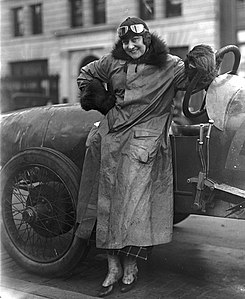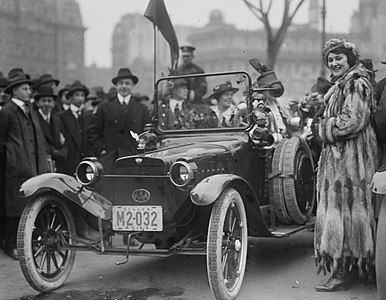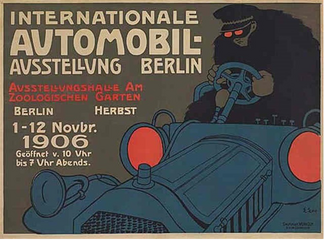Car fur
The car Fur , in his time automobile fur , motorist fur or general driving fur called, sparked in 1900, the time of the distribution of the first automobiles, the former Carriage, carriage and travel furs from. When Mr. fur he founded a mode in which fur, outside the sheepskin - dress was first worn with the hair outward.
history
Traveling by carriage or sledge has always required particularly warm clothing when it is cold. This also applied to the winter clothing for the first automobiles, which were basically nothing more than motorized carriages. A particularly suitable material are long-haired fur skins, which form a strong, heat-retaining air cushion. For this purpose, fur was mainly used as fur lining for cloth coats, long cloth jackets and for fur blankets lined with cloth . While a distinction was still made between the driver's and the passengers' coach pelts, which were sometimes livery-like, in the case of the carriage pelts, this differentiation apparently no longer took place in the case of car furs, at least not in the offers of the fur manufacturers. The driver and front passenger wore furs of the same type. The disappearance of heavy and coarse carter fur around the middle of the 19th century had little influence on the furrier trade, as these leather furs were already covered for road passenger transport in the 1840s.
At the world exhibition in Vienna in 1873 one saw numerous other furs
- from Vienna by MF Neumann an overall for a North Pole driver made of raccoon skin, with "a hood reaching over the shoulder, connected to the front of the face with a mask and eyeglasses are inserted in the same and a mouth opening". The company had equipped the Austrian North Pole expedition with similar suits and sleeping bags. The similarity between some travel furs and the pelts of polar explorers is striking, the thickness of which was reached, if not exceeded, by at least some of the travel furs shown at exhibitions at the time.
- from Russia by M. Peter Medwedeff , Saint Petersburg, “Women's travel coats lined with Chinese white lambskins and worked in the Russian style, namely the lining protruding over the ends”. In addition, two “travel ladies' coats with Tuttelbear” are lined and filled.
- by M. Hoffmann from Vienna fed a ladies traveling coat with white fox and blue fox occupied.
- by MJ Greger from Vienna a ladies' travel coat made of rep lined with Virginian foxes .
- by MJP Hirsch, the company which of all the Viennese exhibitors made "the greatest effort to represent itself worthily", a travel coat lined with noble marten .
- From Galicia, from Armatis , Cracow, came "peasant furs from the most vulgar naked work, gradually represented up to the finest travel furs, and including a travel fur lined and studded with Virginian polecats, a travel fur fed with wolverine [...]".
- by J. Weinhard from Haid in Bohemia a trip from fur on coat length exuberant raccoon fur.
- From E. Rzywnatz from Prague came a raccoon travel fur made in the same way, but additionally galonized with leather strips and therefore only consisting of thirty furs. In addition, a women's travel coat with a white fox lining made in the same way .
From around 1887 a Leipzig furrier, whose main business was travel furs, felt a decrease in demand for this item due to the expansion of the railway network. The tobacco merchant Jury Fränkel (1899–1971) remembered, however, that around 1910 on the train ride to the fur fair in the cold Siberian Irbit, travelers had a so-called Dochá with them, a driving fur , usually a foal coat that was lined with Australian possum .
The term car fur, like travel fur, encompassed particularly warm cloth coats with fur, but it was used specifically for the more conspicuous coats made of long-haired fur. The newly emerging fur wholesale industry offered furs especially for motorists not only in Europe, but also especially in the USA, where Henry Ford manufactured his first motor vehicle in 1903 and, from 1908, sold his famous Model T, the Tin Lizzy , en masse. In America the overcoat had a descriptive name as the “greatcoat”, the long-haired coats of young people that followed it in fashion were just as aptly referred to as “shaggy fur coats”.
With the travel fur and its successor, the car fur, the hair came to the outside in its entirety for the first time, especially in men's coats. And not in a subtle form, but the same lush auftragend and striking from long-haired furs, like sheep , raccoon , goat , wolf , lynx , even skins of large bears and Chinese dogs , and the shorter-haired marmot fur , often with a collar of Seefuchsfell . Not only car covers were offered made of previously neglected or neglected types of fur, such as deer , wombat , wallaby , skunk , hamster and wolverine . Not all types of fur on offer are really suitable for driving, where the fur is particularly stressed. The hard-wearing raccoon fur was rightly very popular, the fur of some goat species is magnificently voluminous, but like deer and reindeer fur , the hair breaks easily.
The preferred, particularly strong fur types had a forerunner in the colder regions of Germany and Europe, the so-called " wild shearing ". The striking, mighty car furs not only warmed the vehicles, which were initially open and for a long time unheated, they also represented the proud owner of this new achievement.
- At the 1901 Paris Motor Show in the “ Grand Palais ” furs from the Parisian company “O. Ström et fils “, tailleur scandinaves
Left: Foalskin skirt and jacket, lynx fur trimmings, ermine fur hood
Middle: fur blankets, fur jacket, fur headgear, lynx necklace , lynx muff
Right: foal coat with lynx collar
In the background: Australian opossum coats
Car fur stood out in an era when women's fashion was reduced in scope to pencil lines. It was also the time when the fashion of fur, which was first worked with the hair facing out, took a tremendous boom; in the form of mainly short-haired pelts. It began in the mid-19th century with a black, waisted Ladies jacket Plucked Seal coat , followed by similar jackets in black astrakhan and coats made of mink . Other popular types of short-haired fur, some of which were used for the first time, were foals and various sheared and mostly black-colored fur, such as rabbit fur and muskrat . In this environment, the often oversized car furs with their broad shoulders and lush driver collars had to appear particularly bizarre.
- Automobile furs of the purveyor to the court Max Erler , Leipzig (after 1900)
The motorist pelts were initially floor-length. In 1908, a large American fur clothing company offered its car furs in lengths of 122 to 127 centimeters, while other companies also offered the more practical paletot length . The company Revillon Frères showed an automobile paletot at the Paris World Exhibition in 1900 , for which 48 raccoon skins and a beaver skin were used for the collar. An automobile paletot made of leopard skin with raccoon trimmings came from the Parisian company Sans-Bresson . Almost anything was allowed on the automobile. Basically, the car driver “dressed so badly” was dressed inappropriately for any other matter. In keeping with the fashion of the time, men always wore headgear outdoors at the beginning of the 20th century, while drivers usually wore a sporty peaked cap with earmuffs that could be folded down, possibly also as a fur hat . Other accessories, in addition to giant glasses, were “giant gloves for giant hands”. In the novel “The Red Champion” by Marie Madeleine from 1906 it says: “You see my dear wife von Weigand, what use is your pretty little figure to you if you hide it in a shapeless automobile fur? What use is the prettiest face in the world if giant glasses cover your eyes and a cap covers your hair and forehead ?! ”In 1910, less voluminous and also less expensive automobile furs made from foal fur for 575 marks and from muskrat headpieces for 590 marks.
In addition to the paletot and the sporty fur, a fur with an additional, everyday use was needed. A reversible short coat about 110 centimeters long, preferably made of short-haired or sheared fur, fulfilled this purpose. The Italian Anna Municchi wrote in retrospect:
“Of course, the fur coat owes a lot to the automobile and so they immediately became friends: It was no coincidence that both turned out to be the male status symbols par excellence. But the automobile owes a real increase in the market, albeit indirectly. The eye-catching fur coat was a great success, which suggests that it was not only bought by the vehicle owners. In the best-stocked fashion houses and in the sales catalogs, the departments dedicated to car accessories are becoming more and more numerous: with due (and splendid) exceptions, pieces are offered at low prices, which are of course much lower than those of the elegant tailor-made paletot.
And the competition is delighted with the search for more affordable materials. [...] "
From the fashion of long-haired men's fur, a fur for wealthy college students developed in the USA in the 1920s / 30s, especially as a raccoon-coat-collegiate fashion. The coat in which the students drove around in the first automobiles was considered a status symbol; "The giant coat from 'raccoon', which had contained the message 'belonging to a famous college', had now entered general use in the 'severe winter version' of sporty outerwear". After him, a fashion epoch of long-haired men's fur came to an end for some time. The railway companies introduced saloon cars , the cars were given a protective roof, and there was no longer any need to carry the extremely warm car furs. They were replaced by leather coats and jackets, some of which were lined with fur.
At least in advertising, the car and fur remained connected. Furs were preferably photographed in front of high-quality motor vehicles - and most expensive motor vehicles together with expensive furs.
Henri Fournier (France, 1898)
- Car furs in art
Poster for the 1906 Berlin International Motor Show, Edmund Edel
Web links
Individual evidence
- ^ Catalog: CA Herpich Söhne, Berlin, Modewaren 1910 , p. 15.
- ↑ a b c Elizabeth Ewing: Fur in Dress . BT Batsford Ltd, London 1981, pp. 119-120 (English).
- ↑ Did you know? In: Rund um den Pelz No. 10, October 1951, Fulde-Verlag Cologne, p. 64.
- ↑ Paul Larisch , Josef Schmid: The furrier craft . Part I, No. 3–4, Chapter The Furrier's Work at the World Exhibition in Vienna 1873 . Larisch and Schmid publishing house, Paris 1902, pp. 27–30.
- ^ Jean Heinrich Heiderich: The Leipziger Kürschnergewerbe . Inaugural dissertation to obtain a doctorate from the high philosophical faculty of the Ruprecht-Karls-Universität zu Heidelberg, Heidelberg 1897, p. 97.
- ^ Jury Fränkel: One-way street - report of a life , first part. Rifra Verlag, Murrhardt, 1971, p. 33.
- ↑ a b picture description: 1904 Fur Fashions. The First Automobiles brought the Long Fur Coat . In: American Furrier combined with Sol Vogel , No. 49, July 1948 (English).
- ↑ Catalog: Lanpher Furs North Star Brand Season 1906-7 Lanpher, Skinner & Co, Saint Paul Minnesota , p. 24.
- ↑ a b c Anna Municchi: The man in the fur coat . Zanfi Editori, Modena 1988, pp. 31ff, 55-56, 58.
- ^ Catalog: The Fur House Max Neuburger & Co, No 598 Broadway, New York, Season 1910-1169 . P. 69.
- ^ R. Turner Wilcox: The Mode in Furs . Charles Scribner Son's, New York and London, 1951, pp. 156-157 (English).
- ^ Catalog: Albrecht Furs, 1908-9, Saint Paul, Minnesota , p. 19.
- ↑ Paul Larisch , Josef Schmid: The furrier craft . Part I, No. 3–4, Chapter The Furrier Work at the 1900 World Exhibition . Larisch and Schmid publishing house, Paris 1902, p. 4, 19.
- ↑ Marie Madeleine: The red champion . P. 134, ISBN 978-80-268-9029-4 . Last accessed November 11, 2018.
- ↑ Without author's name: Rauchware (furs and prices) 1910 . Apparently the catalog of a fur fashion show.
- ↑ Mentges: Leather and Other Cool Materials - On the relationship between clothes, body and technology (PDF). In: Kritischeberichte 4/00, p. 48. Last accessed on November 13, 2018.






